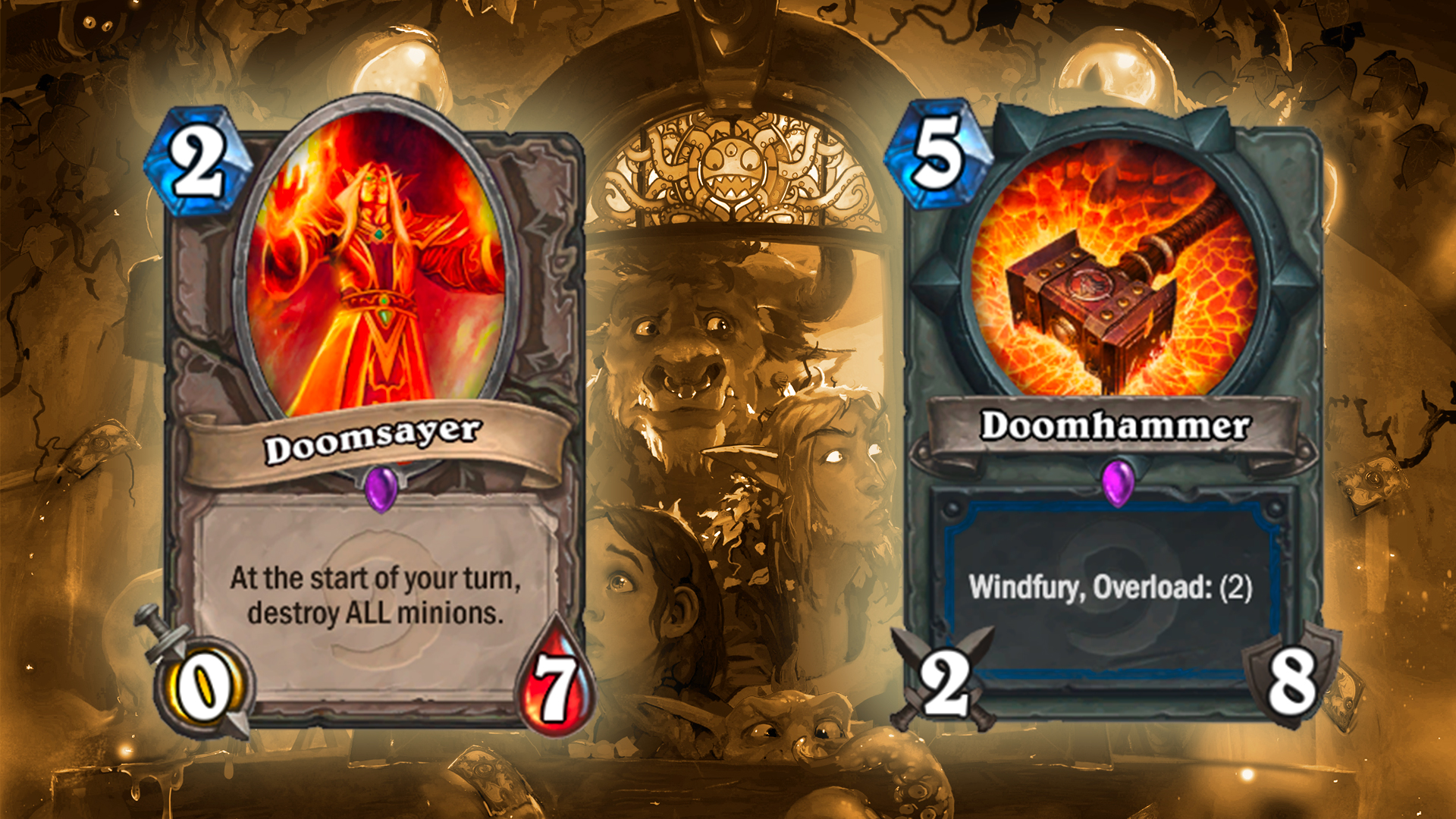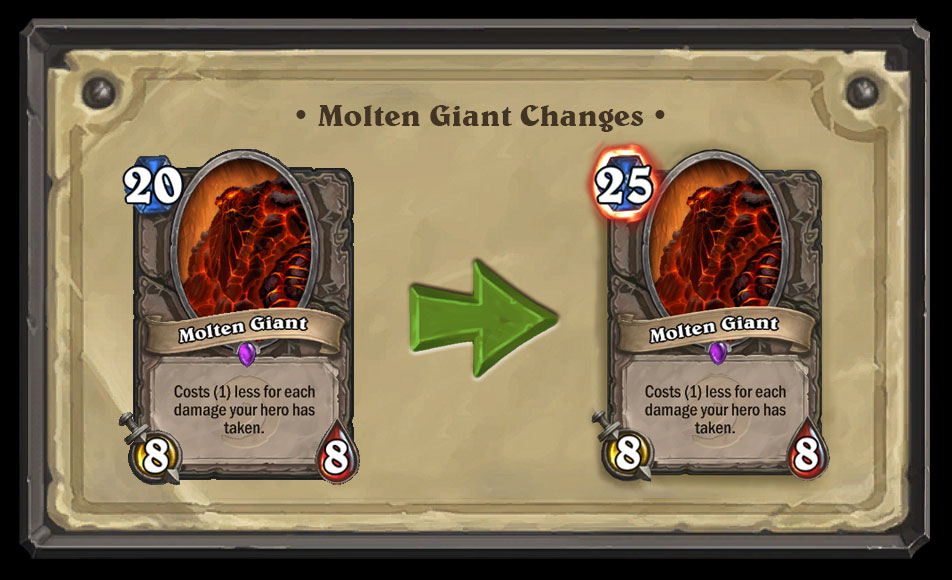Did Hearthstone’s Whispers of the Old Gods nerfs go far enough?
Our friendly pro makes the case for a revamped core set of cards.


Will is a professional Hearthstone player who is currently a free agent, having previously played for ManaLight. His best tournament result was at Dreamhack Cluj-Napoca, where he finished 3rd/4th. He loves to write about the game, having contributed several articles to Team Archon’s site. You can find him on Twitch here and on Twitter here.
A few days before the release of Whisper’s of the Old Gods, the latest Hearthstone expansion, Blizzard swung the nerfhammer. The dozen cards affected were all from the Basic and Expert sets. As things stand, these will be sticking around forever as part of the new “Standard” format, whereas other sets and adventures get rotated out of the competitive pool each year. There are a couple of reasons why Blizzard wants to keep those sets playable in perpetuity. Cards like Frostbolt and Fiery War Axe are a key part of their respective class identity: Mages zap stuff with magic, Warriors, whack them with weapons. Keeping those cards around also prevents lapsed players from coming back to find none of their collection works anymore. (Because let’s be honest: no one plays Wild.) In this piece, I look at whether the cards targeted for nerfs were correct, if the changes have been effective, and which cards escaped but are now proving problematic.
One of the main reason for the nerfs was to redistribute balance between the classes. After all, if these cards are going to be in Hearthstone forever, you don’t want significant power disparity between classes. For example: there has always been a sense that too many of vanilla Hearthstone’s strongest cards belonged to Druid, and so the judicious application of the nerf-bat surprised exactly no one. Ancient of Lore, Druid’s most powerful source of card draw, was nerfed to the point of unplayability. Losing to the old Force of Nature-Savage Roar combo felt about as good as Ben Brode coming to your house dressed as a tree and punching you in the face, so there weren’t too many complaints a stop was put to that.
Why Druid got what it deserved

The important thing to understand about the Druid nerfs is this: The class simply had too many good options, and the easiest way to bring down the overall power level was to make some cards unplayable (relative to their neutral alternatives). ‘Fair’ nerfs could have easily led to those cards still being used, but then Druid as whole would have remained too strong. This is one situation in which the nerfs were harsh, but justified.
Another key motivation for the nerfs was to tackle some neutral cards that were a bit too strong, or promoted a play-style that Blizzard doesn’t regard as fun. Leper gnome got nerfed, because taking 6 damage to the face in the first three turns wasn’t fun. Big Game Hunter got nerfed, because having your Ragnaros get gunned down the turn after you played it wasn’t much fun either. Dying to thousands of tiny little daggers: again, not a barrel of laughs, so Knife Juggler got nerfed. And Master of Disguise was nerfed, because, uh, otherwise we couldn’t have cool cards like... Scaled Nightmare?
As for whether those nerfs should be judged a success, it’s hard to say because of the self-correcting, rock-paper-scissors nature of the Hearthstone metagame. But if the goal was better balance across the classes, it seems bizarre that Blizzard saw fit to leave Doomhammer untouched. With the addition of several bonkers Shaman cards in Whispers of the Old Gods, it was easy to predict Thrall would dominate the ladder. And sure enough, Shaman is certainly the most-played class. And yes, the best deck plays two copies of Doomhammer. And no, being smashed upside the face twice per turn isn’t much fun.
We’re all doomed

Perhaps Blizzard felt that there were enough weapon destruction cards to prevent Doomhammer from ever becoming too oppressive, but I don’t think it represents particularly healthy design. The outcome of games becomes ridiculously polarised: You draw Doomhammer and they play Harrison? You lose. Or vice versa. Even if the results utlimately even out, it still creates the sense that those games are entirely draw dependent, and that isn’t particularly satisfying for either player. Nor is it in keeping with Team 5’s design philosophy, which favours games that see countless little battles for initiative, not big stupid blowouts. There was plenty of complaint from the community when Doomhammer wasn’t nerfed, and as time passes the call only looks worse.
Of all the neutral cards that must have been borderline, the one for which the strongest case for nerfing can be made is Doomsayer. Since Whispers of the Old Gods launched it’s seen a surprising amount of play, and often in otherwise incongruous decks. The popular streamer, MrYagut even put a pair of Doomsayers in his Midrange Hunter deck. That particular version has somewhat faded in popularity now, but the very fact that Doomsayer, nominally a control card, worked in such an aggressively-oriented deck perhaps suggests the card could should be looked at. Personally, I think Doomsayer is just about fine, but in world where Tunnel Trogg into Totem Golem exists, it’s perhaps going to see a disproportionate amount of play.
Keep up to date with the most important stories and the best deals, as picked by the PC Gamer team.
There was some surprising prescience from the balance team when it came to one nerf in particular. The change to Blade Flurry was regarded by many as excessively harsh, with the new version of the card costing twice as much and having a significantly diminished effect. Now, it’s possible that the nerf was a bit harsh, but there can be no argument it was necessary. Miracle Rogue has seen a huge upsurge since Whispers of the Old God, reclaiming its place as a top tier deck. In an environment with far fewer deathrattles, Rogue would have been far too good had Blade Flurry remained in its pre-nerf state.
Giant problems

You could quite reasonably make the criticism that some of the other nerfs were way over the top. Molten Giant stands out as the obvious example: a five mana increase was clearly too much, even in an environment with fewer Big Game Hunters. Blizzard had some flexibility here, but instead chose to effectively delete the card for, as far as I can tell, no real reason. Particularly in a world in which Shaman is capable of slapping down a 7/7 on turn 4 with little risk or setup required. In a similar vein, while no one will mourn the loss of Leper Gnome, changing it to a 1/1 was pretty clearly going to stop it from being played in any deck, ever. There were other options here, too: simply reducing the damage from the deathrattle from 2 to 1 would have been a more measured choice.
The overarching aim of the nerfs seems to have been to create a cohesive core set that gives players a sense of continuity, whilst avoiding overpowered autoinclude cards or ones that can enable egregious strategies. The idea of a stable core set makes a lot of sense, and partly echoes the approach Wizards of the Coast uses with Magic: the Gathering. But MTG’s core set draws from a much wider pool of cards, and changes year on year. This way, the flavor is preserved, but the danger of the game growing stale is considerably lessened. Brian Kibler, of Reddit fame, who you would expect to know a thing or two about balancing cardgames, advocates a similar approach in Hearthstone. This kind of idea would mean Blizzard could decide to keep a card like Lightbomb in the core set for a year if it wanted to give Priest a helping hand, or leave Loatheb around to counter spell-combo decks. Equally, the likes of Gadgetzan Auctioneer and Leeroy Jenkins could be given a timeout for a year.
Core concerns
A related issue is that the Basic and Expert sets seem needlessly flabby. Sure, cards like Fireball and Swipe help preserve class identity, but do we really need Lord of the Arena to be in the playable card pool until the heat death of the universe? How about Raid Leader? Or Silverback Patriarch? Or Magma Rager? It would be a far better idea to give some better options to new players by shifting some of the newer, more viable cards, into the core set.
The developers have justified releasing strict improvements on old cards on the grounds that the original was nowhere close to ever being played. But why, then, would you want that card to remain clogging up the core set? I understand there can be good reasons for having bad cards in games, but having an underpowered Basic set just paints a drab picture for new players who will have to grind using them. Yes, of course Blizzard wants new players to buy packs, but they won’t do that if they give up on the game because their first cards suck and they keep losing while playing with them.
It’s also worth noting that this is only Blizzard’s first pass at rotating sets, and the developer certainly hasn’t ruled out the possibility of taking a different approach in future. That’s good, because doing so would be healthy for the game. Lightly manicuring the base set of cards every year would do a lot to shake up the traditional class identities, and would hopefully mean replacing superfluous basic cards with more playable alternatives. Standard is great, and has brought about a much needed shake-up to a game that was becoming worryingly samey. Changes of almost any sort make Hearthstone more fun, because they create new puzzles to solve. Which is why even a round of nerfs is eagerly anticipated. So keep ‘em coming, starting with Doomhammer please. Overload for 10 should do the trick.

